Name and location
The church was located in the southern corner of the Palatine Hill, and takes its name from the ancient Roman ruin Septizodium of Septimius Severus which was located there. [1] The name septizodium is in turn derived from septisolium, meaning "temple of seven suns," [2] and was probably named for the seven planetary deities (Saturn, Sun, Moon, Mars, Mercury, Jupiter, and Venus), [3] or for the fact that it was originally divided into seven parts. As such, the church of Saint Lucy which was built nearby is variously called in Septisolio,in Septizonium (both of which refer to the Septizodium), in septem solium,de septum solis,de sedes solis (referring to the "seven suns"), or even de septem viae or in septem vias (meaning, "at the seven ways"). [1] The catalogue of Pietro Mallio, produced during the pontificate of Pope Alexander III (1159–1181) calls it S. Lucie Palatii in cyrco iuxta Septa Solis ("[the church of] Saint Lucy of the Palatine, in the circus, near the Seven Suns"). [4] Mariano Armellini assures his readers that these names are all more or less corrupted versions of the same ancient monument's name. [1]
During the height of the Roman stational liturgy in the sixth century until its decline in the eleventh and extinction in the fourteenth, the church served as the ecclesia collecta for Friday of the first week of Lent, meaning that it was the meeting point for the papal procession that then moved to the day's statio, Santi Giovanni e Paolo. [5]
History
The church of Saint Lucy at the Septizodium is mentioned in the Liber Pontificalis as the site of one of the most ancient deaconries of the city. [4] That diaconia is mentioned in the biographies of Pope Leo III (795–816) and Gregory IV (827–844), and was situated next to the church. [1] [4] The church itself is described by Armellini as assai vasta e ricchissimamente decorata, "quite vast and most richly decorated." [1]
Even though the church survived until the time of Pope Sixtus V in a satisfactory condition, Armellini holds that was demolished during his papacy. [1] In doing so, he was echoing the opinion of most authorities, who attributed its destruction to the unique architectural value of the Septizodium; [1] it was demolished so that its pieces could be used in other buildings. Hülsen, however, objects to that theory, positing instead that the church fell into ruins when its cardinalatial title lapsed. [4] He further argues that the church was somewhat removed from the ruins of the Septizodium, and would have stood closer to the Torre della Moletta in the Circus Maximus. [4]

The Basilica of Sts. Vitalis, Valeris, Gervase and Protase is an ancient Catholic church in Rome, and is both a minor basilica and a titular cardinalatial title. It is commonly called the Basilica di San Vitale.
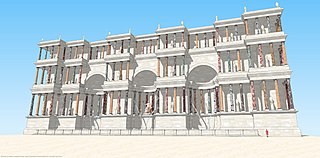
The Septizodium was a building in ancient Rome. It was built in 203 AD by Emperor Septimius Severus. The origin of the name "Septizodium" is from Septisolium, from the Latin for temple of seven suns, and was probably named for the seven planetary deities or for the fact that it was originally divided into seven parts. The building had no known practical purpose and was probably meant to be a decorative façade, known as a Nymphaeum. Ancient and medieval sources describe its purpose as being intended to impress Severus' fellow north Africans as they entered the city, as it was located at the place where the Via Appia passes the Palatine and leads east towards the Forum Romanum. Other examples of septizodia are known, all from Africa.
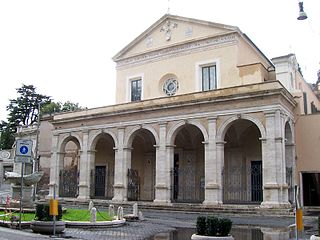
The Minor Basilica of St. Mary in Domnica alla Navicella, or simply Santa Maria in Domnica or Santa Maria alla Navicella, is a Roman Catholic basilica in Rome, Italy, dedicated to the Blessed Virgin Mary and active in local charity according to its long tradition. It has been the titular church of Cardinal Marcello Semeraro since 28 November 2020.

Station days were days of fasting in the early Christian Church, associated with a procession to certain prescribed churches in Rome, where the Mass and Vespers would be celebrated to mark important days of the liturgical year. Although other cities also had similar practices, and the fasting is no longer prescribed, the Roman churches associated with the various station days are still the object of pilgrimage and ritual, especially in the season of Lent.

The Church of Saints Martin and Sebastian of the Swiss is a Roman Catholic oratory in Vatican City. The church was built by Pope Pius V in 1568 to serve as a private chapel for the Pontifical Swiss Guards, whose barracks are located next to Porta San Pellegrino, close to the Apostolic Palace. It is considered the national church of Switzerland in Rome.

The Church of San Pellegrino in Vaticano is an ancient Roman Catholic oratory in the Vatican City, located on the Via dei Pellegrini. The church is dedicated to Saint Peregrine of Auxerre, a Roman priest appointed by Pope Sixtus II who had suffered martyrdom in Gaul in the third century. It is one of the oldest churches in the Vatican City.

Santi Celso e Giuliano is a minor basilica church in Rome, Italy. It has held this status by custom and practice since ancient times. The church is located on Vicolo del Curato number 12, just off Via del Banco di Santo Spirito, the road leading to Ponte Sant'Angelo.

San Giacomo alla Lungara is a church in Rome (Italy), in the Rione Trastevere, facing on Via della Lungara. It is also called San Giacomo in Settimiano or in Settignano, due to its vicinity to Porta Settimiana, built by Septimius Severus and included by Aurelianus within the city walls.
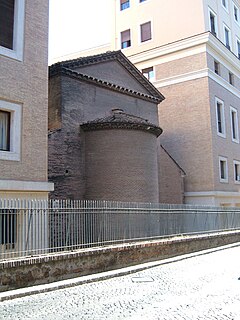
The Church of San Lorenzo in Piscibus is a 12th-century small church in the Borgo rione of Rome. It is located near Saint Peter's Square and Vatican City, but its façade is not visible from the main street, Via della Conciliazione.

Santa Caterina da Siena is a church in Rome dedicated to Catherine of Siena. It is sited on via Giulia in the Regola district.

Sant'Antonio abate all’Esquilino is a church in Rome, located near the Basilica of Santa Maria Maggiore on via Carlo Alberto in the Esquilino district.

The church of Sant'Egidio in Borgo, ...a Borgo, or ...in Vaticano, is a Roman Catholic oratory in Vatican City dedicated to Saint Giles.
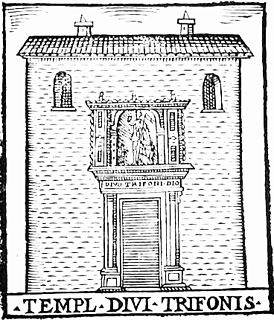
San Trifone in Posterula was an ancient titular church of Rome, now lost. It was located at the corner of Via dei Portoghesi and Via della Scrofa, in the Campo Marzio rione of the city.
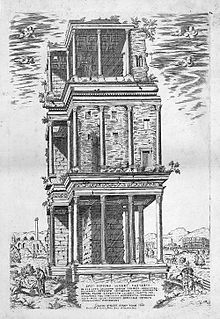
The Domus Severiana is the modern name given to the final extension to the imperial palaces on the Palatine Hill in Rome, built to the south-east of the Stadium Palatinum in the Domus Augustana of Septimius Severus. It included the Baths of Septimius Severus.

San Sebastiano de Via Papae was a small church in the Sant'Eustachio rione of Rome that was demolished in the 1590s in order to enable the construction of the church of Sant'Andrea della Valle.

Santi Sergio e Bacco al Foro Romano also called Santi Sergio e Bacco sub Capitolio was an ancient titular church in Rome, now lost. Located in the ruins of the Roman Forum, it had been one of the ancient diaconiae of the city and a collect church for one of the station days of Lent, but it was demolished in the sixteenth century.
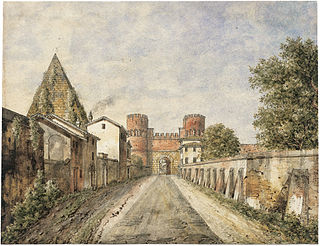
San Menna was an ancient church in Rome, formerly located along the Via Ostiensis which led to the Basilica of Saint Paul. It appears to have been destroyed at some point after the tenth century.
San Ciriaco de Camiliano was an ancient church of the city of Rome, formerly located on the present site of the Piazza del Collegio Romano near the Via del Corso. It was demolished in 1491 during construction on the church of Santa Maria in Via Lata.

Santa Maria in Monterone is a Roman Catholic church in Rome, Italy. Its suffix originates from the Sienese Monteroni family, whose patronage rebuilt the church and built a small hospice next to it for pilgrims from Siena. It is located on Via Santa Maria in Monterone in the Sant'Eustachio rione. Next to the church is a Redemptorist monastery, whose clergy manage the church.

Sant'Agata in Trastevere is one of the churches of Rome, located in the Trastevere district, at Largo San Giovanni de Matha, 91.


















